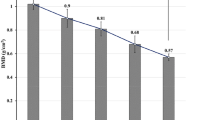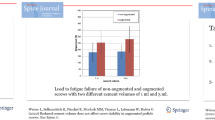Abstract
We investigate the anchorage of pedicle screws with different surface treatments in osteoporotic bone. Eight ewes were divided into two groups of four animals each: four sheep underwent bilateral ovariectomy (OVX Group), whereas the operation was simulated in the remaining group (SHAM Group). Eighteen months after the first operation, the Dynesys® System was fitted to the sheep using pedicle screws with three different surface treatments: untreated, rough blasted (uncoated) and bioactive coated (bioactive). Uncoated screws showed a significantly higher bone ingrowth value compared with the untreated screws in the OVX group (9.3%, p < 0.005) and a significantly lower bone ingrowth value in the SHAM group (−11.0%, p < 0.05). Furthermore, the bioactive pedicle screws had a significant lower bone ingrowth value than the untreated screws in the SHAM group (−12.1%, p < 0.05). These results suggest that both tested surface treatments of pedicular screws may provide an advantage in terms of bone quality and osseointegration, when implanted in osteoporotic vertebrae.



Similar content being viewed by others
References
Boden SD (1998) Bone repair and enhancement of clinical trial design: spine applications. Clin Orthop 355:336–346. doi:10.1097/00003086-199810001-00033
Stoll TM et al (2002) The dynamic neutralization system for the spine: a multi-center study of a novel non-fusion system. Eur Spine J 11:S170–S178. doi:10.1007/s00586-002-0438-2
Mulholland RC (2008) The myth of lumbar instability: the importance of abnormal loading as a cause of low back pain. Eur Spine J 17(5):619–625. doi:10.1007/s00586-008-0612-2
Beastall J et al (2007) The Dynesys lumbar spinal stabilization system: a preliminary report on positional magnetic resonance imaging findings. Spine 32:685–690. doi:10.1097/01.brs.0000257578.44134.fb
Schlegel JD et al (1996) Lumbar motion segment pathology adjacent to thoracolumbar, lumbar, and lumbosacral fusions. Spine 21:970–981. doi:10.1097/00007632-199604150-00013
Galbusera F et al (2008) Design concepts in lumbar total disc arthroplasty. Eur Spine J 17:1635–1650. doi:10.1007/s00586-008-0811-x
Mulholland RC, Sengupta DK (2002) Rationale, principles and experimental evaluation of the concept of soft stabilization. Eur Spine J 11:S198–S205. doi:10.1007/s00586-002-0422-x
Frankel BM et al (2007) Segmental polymethylmethacrylate augmented pedicle screw fixation in patients with bone softening caused by osteoporosis and metastatic tumor involvement: a clinical evaluation. Neurosurgery 61:531–537. doi:10.1227/01.NEU.0000290899.15567.68 discussion 537–538
Halvorson TL et al (1994) Effects of bone mineral density on pedicle screw fixation. Spine 19:2415–2420. doi:10.1097/00007632-199411000-00008
Upasani VV et al (2009) Pedicle screw surface coatings improve fixation in nonfusion spinal constructs. Spine (Phila Pa 1976) 34(4):335–343. doi:10.1097/BRS.0b013e318194878d
Carmouche JJ et al (2005) Effects of pilot hole preparation technique on pedicle screw fixation in different regions of the osteoporotic thoracic and lumbar spine. J Neurosurg Spine 3:364–370. doi:10.3171/spi.2005.3.5.0364
Cook SD et al (2001) Lumbosacral fixation using expandable pedicle screws. an alternative in reoperation and osteoporosis. Spine J 1:109–114. doi:10.1016/S1529-9430(01)00020-1
Nicoli Aldini N et al (2002) Pedicular fixation in the osteoporotic spine: a pilot in vivo study on long-term ovariectomized sheep. J Orthop Res 20:1217–1224. doi:10.1016/S0736-0266(02)00069-4
Fransen P (2007) Increasing pedicle screw anchoring in the osteoporotic spine by cement injection through the implant. Technical note and report of three cases. J Neurosurg Spine 7:366–369. doi:10.3171/SPI-07/09/366
Fini M et al (2003) Biological assessment of the bone–screw interface after insertion of uncoated and hydroxyapatite-coated pedicular screws in osteopenic sheep. J Biomed Mater Res 66:176–183. doi:10.1002/jbm.a.10605
Fini M et al (2003) Biomechanical and histomorphometric investigations on two morphologically differing titanium surfaces with and without fluorohydroxyapatite coating: an experimental study in sheep tibiae. Biomaterials 24:3182–3192. doi:10.1016/S0142-9612(03)00164-9
Giavaresi G et al (2003) Mechanical and histomorphometric evaluations of titanium implants with different surface treatments inserted in sheep cortical bone. Biomaterials 24:1583–1594. doi:10.1016/S0142-9612(02)00548-3
Giavaresi G et al (2004) Different diagnostic techniques for the assessment of cortical bone on osteoporotic animals. Biomed Pharmacother 58:494–499. doi:10.1016/j.biopha.2004.08.017
Nicoli Aldini N et al (2004) Osseointegration of bioactive glass-coated and uncoated zirconia in osteopenic bone: an in vivo experimental study. J Biomed Mater Res 68A(2):264–272. doi:10.1002/jbm.a.20057
Schwarzenbach O et al (2005) Posterior dynamic stabilization systems: DYNESYS. Orthop Clin N Am 36:363–372. doi:10.1016/j.ocl.2005.03.001
Kim HM et al (2000) Formation of bioactive functionally graded structure on Ti-6Al-4 V alloy by chemical surface treatment. J Mater Sci Mater Med 11:555–559. doi:10.1023/A:1008924102096
Spriano S et al (2005) Characterisation of surface modified Ti-6Al-7Nb alloy. J Mater Sci Mater Med 16:301–312. doi:10.1007/s10856-005-0628-7
Parfitt AM et al (1987) Bone histomorphometry: standardization of nomenclature, symbols, and units. Report of the ASBMR histomorphometry nomenclature committee. J Bone Miner Res 2:595–610. doi:10.1002/jbmr.5650020617
Spriano S et al (2005) Surface properties and cell response of low metal ion release Ti-6Al-7Nb alloy after multi-step chemical and thermal treatments. Biomaterials 26:1219–1229. doi:10.1016/j.biomaterials.2004.04
Chappard D et al (1999) The early remodeling phases around titanium implants: a histomorphometric assessment of bone quality in a 3- and 6-month study in sheep. Int J Oral Maxillofac Implants 14:189–196
Spriano S et al (2005) New chemical treatment for bioactive titanium alloy with high corrosion resistance. J Mater Sci Mater Med 16:203–211. doi:10.1007/s10856-005-6681-4
Iannuzzi A et al (2010) In vivo deformation, surface damage, and biostability of retrieved Dynesys systems. Spine 35:E1310–E1316. doi:10.1097/BRS.0b013e3181d6f84f
Ko CC et al (2010) Screw loosening in the Dynesys stabilization system: radiographic evidence and effect on outcomes. Neurosurg Focus 28:E10. doi:10.3171/2010.3.FOCUS1052
Liu CL et al (2010) Influence of Dynesys system screw profile on adjacent segment and screw. J Spinal Disord Tech 23:410–417. doi:10.1097/BSD.0b013e3181b63d89
Meyer CM et al (2008) Discrepancies in T-score readings between patients with asymmetrical gait. J Am Geriatr Soc 56:758. doi:10.1111/j.1532-5415.2008.01642.x
Fini M et al (2000) The ovariectomized sheep as a model for testing biomaterials and prosthetic devices in osteopenic bone: a preliminary study on iliac crest biopsies. Int J Artif Organs 23:275–281
Giavaresi G et al (2001) The ovariectomized ewe model in the evaluation of biomaterials for prosthetic devices in spinal fixation. Int J Artif Organs 24:814–820
Turner et al (1993) Static and dynamic histomorphometric data in 9-to 11-years old ewes. Poster Session Abstracts-ACVS: 413
Rocca M et al (2002) Osteointegration of hydroxypapatite-coated and uncoated titanium screws in long-term ovariectomized sheep. Biomaterials 23:1017–1023. doi:10.1016/S0142-9612(01)00213-7
Wilke HJ et al (1997) Are sheep spines a valid biomechanical model for human spines? Spine 2:2365–2374
Acknowledgments
The Authors wish to thank Mr. Keith Smith for his assistance in language supervision.
Conflict of interest
None.
Author information
Authors and Affiliations
Corresponding author
Rights and permissions
About this article
Cite this article
Giavaresi, G., Fini, M., Giardino, R. et al. In vivo preclinical evaluation of the influence of osteoporosis on the anchorage of different pedicle screw designs. Eur Spine J 20, 1289–1296 (2011). https://doi.org/10.1007/s00586-011-1831-5
Received:
Revised:
Accepted:
Published:
Issue Date:
DOI: https://doi.org/10.1007/s00586-011-1831-5




